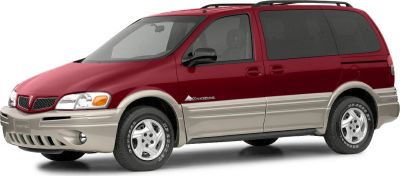 1995 Ford Windstar I Dimensions, Size & Specs
1995 Ford Windstar I Dimensions, Size & SpecsMeasurements of the 1995 Ford Windstar I, engineered for optimal performance and comfort
| Dimensions | |
|---|---|
| Length: | 5125-5162 mm201.8-203.2 in16.8-16.9 ft |
| Width: | 1915 mm75.4 in6.3 ft |
| Height: | 1790 mm70.5 in5.9 ft |
| Trunk Capacity: | 615 liter21.7 cu ft |
| Trunk Capacity (Max): | 4080 liter144.1 cu ft |
| Weight Specifications | |
| Curb Weight: | 1693-1810 kg3732-3990 lbs |
| Maximal permitted Weight: | 2440 kg5379 lbs |
| Tire Specifications | |
| Rims Size: |
|
| Tire Sizes: |
|
The Ford Windstar I represents Ford's first-generation minivan available for model years 1995 to 1996. Designed to cater to families and those needing spacious, versatile transport, it offered practical dimensions and ample interior capacity. The vehicle's overall length ranges from 5125 mm to 5162 mm (201.8 to 203.3 inches), providing a roomy interior while maintaining manageable external size for urban and highway driving. The width stands at 1915 mm (75.4 inches), and height varies slightly between 1789 mm and 1790 mm (70.4 to 70.5 inches), contributing to a comfortable open cabin atmosphere with good headroom.
The Windstar I weighs between 1693 kg and 1810 kg (3731 to 3992 lbs) curb weight, with a maximum gross weight of 2440 kg (5378 lbs), ensuring stability and durability while handling family or cargo loads. Its luggage capacity is noteworthy; standard rear storage offers 615 liters (21.7 cubic feet) sufficient for everyday luggage needs. When the rear seats are folded, the capacity dramatically expands to 4080 liters (144.1 cubic feet), enabling transport of bulky items or large cargo volumes.
Equipped with 15-inch rims and tire options including 205/75 R15 and 205/70 R15, the Windstar ensures a balanced ride suitable for various road conditions. Overall, the 1995-1996 Ford Windstar I blends spaciousness, practical dimensions, and solid weight capacity, making it a key player in the minivan segment of its era.
Discover the standout features that make the 1995 Ford Windstar I a leader in its class
Have a question? Please check our knowledgebase first.
The 1995-1996 Ford Windstar I has a length ranging from 5125 mm to 5162 mm (201.8 to 203.3 inches). This considerable length contributes to its strong road presence typical of a full-sized minivan, providing ample interior space for passengers and cargo. The length allows for three rows of seating and generous legroom, making it suitable for families or group travel. However, the size also means it can be more challenging to maneuver and park in tight urban spaces compared to smaller vehicles.
The Ford Windstar I measures 1915 mm (75.4 inches) in width. This width ensures a spacious cabin interior for three passengers per row and ample shoulder and hip room. On the road, this width is fairly standard for minivans but might require attention when driving on narrow streets or tight lanes. While not overly wide compared to other vehicles in its class, drivers might find it slightly challenging to navigate densely packed urban areas or narrow rural roads.
The height of the 1995-1996 Ford Windstar I ranges between 1789 mm to 1790 mm (70.4 to 70.5 inches). This height provides generous headroom for passengers, adding to overall comfort, especially for taller individuals. The moderately tall stature also facilitates easier ingress and egress from the vehicle. However, the relatively tall profile can impact vehicle stability compared to lower-profile cars, particularly in strong crosswinds or during sharp cornering, a common consideration in minivan design.
The 1995-1996 Ford Windstar I has a curb weight ranging from 1693 kg to 1810 kg (3731 to 3991 pounds). Its maximum weight capacity is 2440 kg (5379 pounds). The curb weight contributes to the structural sturdiness and safety of the vehicle but also affects acceleration, braking, and fuel efficiency. Heavier vehicles typically consume more fuel, and this is true for the Windstar I. The maximum weight includes passengers, cargo, and additional accessories, so adhering to this limit is important to maintain performance and safety standards.
With all seats in place, the Ford Windstar I offers a luggage capacity of approximately 615 liters (21.7 cubic feet). This space is adequate for typical family outings and everyday errands. When the rear seats are folded down, the luggage capacity dramatically increases to 4080 liters (144 cubic feet), transforming the minivan into a large cargo hauler capable of transporting bulky items or accommodating significant loads for moving or long trips. This versatility is a key advantage for minivan owners.
A standard residential garage typically measures about 2440 mm to 2740 mm (8 to 9 feet) in width and 4880 mm to 6096 mm (16 to 20 feet) in length. Given that the Ford Windstar I has a width of 1915 mm (75.4 inches) and a length up to 5162 mm (203.3 inches), it should comfortably fit in most single-car garages in terms of physical space. However, when considering additional clearance for opening doors and maneuvering, especially in older or smaller garages, it might feel a bit tight. The height of roughly 1790 mm (70.5 inches) is not usually a concern since most garages have adequate vertical clearance.
The 1995-1996 Ford Windstar I was Ford's first minivan in the Ford lineup, essentially replacing the earlier Ford Aerostar. Compared to the Aerostar, the Windstar I is generally larger in length and width, offering more interior space and modern minivan attributes such as improved seating flexibility and cargo capacity. Dimensionally, it aligns well in size with contemporaries such as the Dodge Caravan and Chevrolet Lumina APV, providing competitive interior volume and luggage space. Its bigger footprint and modern design aimed to attract families looking for more comfort and utility than previous models.
The 1995-1996 Ford Windstar I typically comes with 15-inch rims fitted with tire sizes 205/75 R15 or 205/70 R15. These tire dimensions offer a balanced ride comfort and sufficient sidewall height to absorb bumps and road imperfections, ideal for family minivan use. Larger sidewalls generally contribute to softer rides but can slightly reduce handling precision compared to lower-profile tires. The choice reflects a focus on passenger comfort and typical minivan driving conditions rather than sporty handling.
The Ford Windstar I was praised in the mid-1990s for its spacious and flexible interior, accommodating up to seven passengers comfortably with three rows of seating. The generous width of 1915 mm (75.4 inches) and overall length enhances legroom and shoulder space compared to some competitors. The minivan's smooth ride and quiet cabin were also notable selling points. Its large luggage capacity and fold-flat rear seats gave it an edge in versatility, appealing to families and those requiring both passenger and cargo transportation ease.
The sizeable dimensions of the Ford Windstar I, especially its length (up to 5162 mm / 203.3 inches), width (1915 mm / 75.4 inches), and curb weight (up to 1810 kg / 3991 lbs), contribute to a vehicle that is more fuel-consuming than smaller cars. In urban environments, the larger footprint can make maneuvering more complex and fuel consumption higher due to frequent stops and idling. On highways, the Windstar offers stable and comfortable cruising, with aerodynamics typical of minivans influencing fuel efficiency moderately. Overall, the vehicle prioritizes passenger comfort and space over fuel economy and sporty driving dynamics.
Discover similar sized cars.

| Production: | 1996-1999 |
|---|---|
| Model Year: | 1997 |
| Length: | 4750-5115 mm187.0-201.4 in |
| Width: | 1845 mm72.6 in |
| Height: | 1710-1730 mm67.3-68.1 in |

| Production: | 1996-2004 |
|---|---|
| Model Year: | 1997 |
| Length: | 4755-5113 mm187.2-201.3 in |
| Width: | 1830-1847 mm72.0-72.7 in |
| Height: | 1710-1730 mm67.3-68.1 in |

| Production: | 1999-2001 |
|---|---|
| Model Year: | 1999 |
| Length: | 5125 mm201.8 in |
| Width: | 1915 mm75.4 in |
| Height: | 1790 mm70.5 in |

| Production: | 2000-2010 |
|---|---|
| Model Year: | 2000 |
| Length: | 5115 mm201.4 in |
| Width: | 1845 mm72.6 in |
| Height: | 1730 mm68.1 in |

| Production: | 2018-2023 |
|---|---|
| Model Year: | 2019 |
| Length: | 5130 mm202.0 in |
| Width: | 1915 mm75.4 in |
| Height: | 1815 mm71.5 in |

| Production: | 2012-2018 |
|---|---|
| Model Year: | 2013 |
| Length: | 5130 mm202.0 in |
| Width: | 1915 mm75.4 in |
| Height: | 1815 mm71.5 in |

| Production: | 2004-2013 |
|---|---|
| Model Year: | 2004 |
| Length: | 5130 mm202.0 in |
| Width: | 1915 mm75.4 in |
| Height: | 1820 mm71.7 in |
